In the United States, on the one hand, the sustainable development trajectory has been full of ups and downs like a pendulum swinging back and forth with every change in executive power. In Germany, on the other hand, the policies based on the idea of sustainable development evolved accumulatively and the idea was slowly but surely institutionalized. As a result, Germany has a sustainable development policy regime, while the U.S. does not. (Rost 32)
Germans tend to look towards the federal government when it comes to setting an environmental agenda. It was Chancellor Gerhard Schröder’s red-green coalition’s initiative for the so-called Energiewende at the turn of the millennium and its confirmation by Chancellor Angela Merkel that inspired legislation to transform the country’s energy supply, although its success has been a matter of debate. But in the United States, change does not usually originate with the federal government; instead, it comes from the local and state levels. Grassroots movements often drive change such as the Civil Rights, the Women’s, or the Gun Control Movement. Legislation on the state level allows for change that would be much more difficult to achieve on the federal level, but it impacts legislative action in Washington DC. Once students understand this fundamental difference between the German and the US political system, they are open for a different kind of narrative. And this narrative goes something like this:
3California Governor Jerry Brown signed legislation on September 10, 2018, setting the groundwork for a new, ambitious energy goal: getting 100 percent of the state’s electricity from non-carbon sources like solar and wind by 2045. The fifth largest economy in the world, California—through its energy and emission policy—influences other US states, even countries, corporations, and businesses. Several US states mostly in the northwest and northeast have adopted this legislation so far. It’s not just ‘liberal’ states that pursue an environmental agenda—which is surprising to many Germans. In June 2017, the New York Times announced under the headline, “In Trump Country, Renewable Energy Is Thriving”:The five states that get the largest percentage of their power from wind turbines—Iowa, Kansas, South Dakota, Oklahoma and North Dakota—all voted for Mr. Trump. So did Texas, which produces the most wind power in absolute terms. In fact, 69 percent of the wind power produced in the country comes from states that Mr. Trump carried in November. (Gillis and Popovich)
Though initiatives for sustainable development in these states are driven more by economic considerations rather than an openly stated belief in climate change, the result remains the same: Energy production and consumption in the United States are changing on a massive scale.
4Many more counter-narratives challenging the strongly held perceptions of German students and the general public could be added here, but the point is: The United States of America is a very complex political and social system. Even the Trump administration’s withdrawal from the Paris Climate Agreement does not mean that climate action in the US has stalled—quite the opposite. State Department officials are still participating in climate conference negotiations since officially, “the process of withdrawal can only begin the day after the 2020 U.S. presidential elections” (Roberts). 5To cut a long story short: Despite the US federal government’s recent policy changes, environmental stewardship is alive and well on state and local levels. This is the focus of “Going Green – Education for Sustainability,” an intercultural blended-learning project for the EFL and CLIL classrooms located on teachaboutus.org, where a demo course can be accessed. The project goal is by no means simple: Besides teaching EFL as well as digital literacies, the task also involves countering a narrative based on limited knowledge, stereotypes, and misperceptions; raising awareness about the challenges the world faces; and initiating cooperation between American and German students to combat and manage climate change. 6Subsequently, we first introduce the Going Green project along with its pedagogical rationale and a discussion of cultural learning in this setting. In so doing, we focus on the role of mainstream vs. counter-narratives of sustainable development in the US and pedagogical approaches to teaching them in the EFL classroom. In order to contextualize some of the potential challenges of such an approach, we report a questionnaire survey of previous project participants’ perceptions and preconceptions of sustainable development in the US. The reported data illustrate that learners are often unaware of non-mainstream publics and the impact of the local and state government-levels to support sustainable development in the US. We close by discussing the role of such counter-narratives in the teaching of culture and how they are implemented in the Going Green curriculum.Going Green – Education for Sustainability
The Concept Behind Going Green
7An annual school project that was first implemented in 2014, Going Green has since attracted over 3,000 participants mostly in Germany and the US. Participants in both countries enroll in an online course on a Moodle-based learning management system (LMS), “Teach About US” and engage in project work throughout the school year. The annual project cycle ends with a student competition recognizing creative and innovative approaches to sustainable development through local action plans. A concluding student conference amplifies these actions by providing a national audience for the learners’ projects and allowing them to connect with other participants. Since 2014, participants have submitted over 70 action plans, which have been documented on the platform and serve as models to current and future participants. 8In terms of foreign language pedagogy, the project builds on the three pillars of task-based language learning, computer-assisted language learning, and intercultural communicative competence. Content-based task cycles are the organizing unit of the project curriculum. In keeping with the principles of communicative language teaching, they are designed to emulate real-life topics and communicative practices that learners encounter outside their classrooms. They adopt a focus on communicative and non-communicative outcomes, and challenge learners both linguistically and otherwise to stretch their competencies beyond current levels to achieve learning goals (Nunan). Content-based and transdisciplinary language learning tasks and projects have been widely described as suitable for the joint learning about sustainable development and language in the research literature (Bartosch and Köpfer; Bogaert et al.; Bonnet; Hauschild, Poltavtchenko, Stoller). 9The Going Green curriculum is made available digitally via the LMS Moodle, allowing for a flexible blended learning format to complement traditional (i.e., analog) classroom practice. The platform is a hybrid space that connects digital and face-to-face practices and provides opportunities for distributing materials and information. It allows for classroom management, and communication and collaboration within and beyond the traditional classroom boundaries, especially across the Atlantic with other project participants (Kaliampos).Guiding Learners in a Digital Environment
10While the LMS functions as the basis for exploring the Going Green curriculum, the actual engagement is not effortless and needs to be carefully guided. Educational research has demonstrated over the past fifteen years that the early hype around digital technologies in the classroom and the view on millennial learners as “digital natives” (Prensky) or the “net generation” (Oblinger and Oblinger) are misguided. Applied linguistic research adopting learner tracking in digital spaces (Chun; Fischer) and examining the role of learner training (Hubbard) has shown that many students have little experience in using pedagogic software, often take unstructured and erratic learning paths, and frequently overlook or misinterpret affordances of tools and applications. 11Nevertheless, today’s learners have mostly been socialized into digital technology use in virtually all parts of their lives and are motivated by technology integration in the classroom. They expect to use it in much the same way as they already apply digital practices to express their identity and routinely engage in multi-tasking and task-switching. They act as ‘prosumers’ of digital content using technology outside the classroom. Specifically, the various discursive practices on sustainable development are mediated by digital tools. When learners are expected to participate in these foreign language discourses themselves, they must develop the digital literacy skills needed as well as an awareness of concomitant genre structures. 12For instance, social media users around the globe connect through hashtags like #greenliving or #zerowaste on platforms like Instagram to portray sustainable behavior and environmental stewardship, thereby foregrounding the transnational nature of questions, such as the reduction of plastic or the limitation of greenhouse gas emissions. Likewise, NGOs like the Surfrider Foundation as well as individual youth activists like Greta Thunberg, initiator of the “Fridays for Future” student protests, or entrepreneur Boyan Slat, who is working on a system to clean up plastic waste in the ocean, have gained worldwide recognition and directed attention to the issues they advocate through their viral online presence.Tackling Environmental Challenges and Cultural Stereotypes as Global Citizens
13The approach to cultural learning in Going Green can be framed within global citizenship education, which opens new avenues for content-driven language learning by foregrounding themes of global relevance, such as human rights issues or the degradation of the environment. These affect learners directly in their communities, regardless of national borders, political systems, or linguistic and sociocultural context. English is instrumental here as an international lingua franca—a communicative tool used by native and non-native speakers alike in technology-mediated communicative and collaborative settings to achieve shared outcomes. 14Global education closes in on the many ways that learners’ lives are interwoven with transnational challenges by way of personal lifestyle choices and everyday habits. Because the local and the global are intricately intertwined, global learning can involve a normative impetus and a moral imperative by emphasizing individual and collective agency as well as the shared responsibility for solving global challenges at the community level (Volkmann “Challenging the Paradigm”). This pragmatic orientation, which draws on the development and exercise of learner agency in multiple domains (linguistic, scientific, sociocultural, political, digital, and potentially other types of agency), is characteristic of global education. It fosters development in the areas of knowledge (about world countries and cultures as well as about global problems, their causes and solutions), skills (of critical thinking, cross-cultural communication, cooperative problem solving, conflict resolution, and the ability to see issues from multiple perspectives), attitudes (of global awareness, cultural appreciation, respect for diversity, and empathy), and action (following the call to ‘think globally, act locally’) (Cates). 15It follows that intercultural communication, understanding, and mediation as well as values of empathy, social equity, and environmental justice can be subsumed under this concept. Current scholarship in foreign language pedagogy emphasizes that modern societies are shaped by tendencies of globalization, digitalization, migration, and mobility. The notion of transculturality is core to this idea and refers to the inner differentiation, polyphony, cultural complexity, hybridity, external interconnectedness with other cultures (Freitag-Hild 167). At the level of the individual, such cultural dynamism, fragmentation, and hybridity is mirrored by multilayered and pluralistic self-concepts which, mediated by mobile and social media, offer multiple options for identification and deliberate identity development. 16While intercultural approaches emphasize comprehension across cultural boundaries and the coordination of different cultural perspectives (Bredella), transcultural pedagogies examine the blurring of such categorical distinctions due to modern societies’ inner differentiation and external interconnectedness. This can be observed particularly well in cases of individuals’ multilayered identity constructions or the structure of modern subcultures and transnational movements that are not typically contained by national borders (Freitag-Hild). 17Central to these pedagogies is the role of learners’ cultural stereotypes and preconceptions, which may be perpetuated and reinforced if left unaddressed. According to Lippmann’s seminal definition, education and stereotypes are closely linked: “We are told about the world before we see it. We imagine most things before we experience them. And those preconceptions, unless education has made us acutely aware, govern deeply the whole process of perception” (90). Stuart Hall has described stereotypes as exaggerated cultural representations that “take hold of the memorable characteristics, reduce them, exaggerate them, and simplify them without change or development to eternity. So stereotyping reduces, essentializes, naturalizes, and fixes differences” (qtd. in Rosenthal et al. xi). Foreign language research in Germany, for example, has investigated the role of stereotypes and national images in learner textbooks (Anton; Schulze), children’s and young adult literature (O’Sullivan), and popular culture (Rosenthal et al.). Anton has recently demonstrated that the majority of EFL textbooks published in Germany inadequately, if at all, incorporate a reflective dimension regarding stereotypes and images of self and other. This is problematic, given the consensus within the social sciences and (foreign language) pedagogy that cultural and national stereotypes as well as their cognitive functions are a form of tacit knowledge and should be made explicit, deconstructed, and critically reflected upon to avoid their fossilization and reinforcement (Adloff, Gerund, Kaldewey; O’Sullivan and Rösler 339; Thiele 27–28; Volkmann “Nature and Function of Stereotypes”). 18As a consequence, stereotypes should be expected to play a significant role for intercultural learning within Going Green and must be rendered salient to become susceptible to critical reflection and deconstruction. Such an approach, we argue, would entail determining what kinds of stereotypes exist among learners, what aspects of the target culture they address in which ways, and what cognitive, social, and political functions they serve. It seems plausible that, if such critical questions remain neglected, the ambitious goal of developing global citizenship skills in the context of environmental issues is jeopardized. This issue was addressed by Svea Burmester’s introspective and observation-based study of two Going Green participant courses. From the perspective of political education and deliberation, she argues that the project curriculum must help raise learners’ awareness of their cultural stereotypes so that the aforementioned global citizenship skills can be developed:In the case of Going Green, its topic of environmental sustainability clearly represents a common good, thus suggesting a high deliberative potential, but the issue is also controversial due to prejudiced perceptions that Germans and Americans maintain towards each other regarding their respective attitudes to the environment. (Burmester 15)
The subsequent study on learner stereotypes and preconceptions examines these aspects in the context of Going Green. Before doing so, we briefly introduce the project curriculum.
Facts are Crucial, but not Enough
19As the cursory discussion of the project’s theoretical rationale shows, the goal of tackling cultural stereotypes and attitudes towards sustainability as well as facilitating learner agency is not merely a matter of knowledge transfer. Simply confronting learners with facts and supporting them in engaging with the topic cognitively, although an important first step, is not likely to bring about attitudinal or behavioral changes. Paralleling existing research on stereotypes and cultural learning (Byram; Cates), Ursula Heise describes three layers of ecocriticism that can be exploited for the teaching of sustainability in an intercultural context. Ecocriticism, she argues, involves the study of nature (which is characteristic of science), the scholarly analysis of its cultural representations (as prevalent in the humanities), and engagement in the political struggle for more sustainable ways of inhabiting the natural world. The latter foregrounds the role of sociopolitical participation, learner agency, and foreign language discourse competence. Focusing on transcultural EFL learning, Siepmann proposes a similar sequence of concept, discourse, and action phases to implement transcultural learning pedagogically. We draw on both models to outline the three project phases of Going Green (see figure 1). 20In the first part, the “concept” phase, learners activate prior knowledge and deepen their theoretical concept knowledge by proposing, revising and extending working definitions of key sustainability concepts. This phase corresponds with the first dimension (i.e., the study of nature) in Heise’s model. In Going Green, learners begin by filling out a questionnaire on attitudes and prior knowledge regarding sustainable development in the US and critically compare each other’s responses. Then, they contribute these definitions of foundational concepts (e.g., sustainability, the ecological footprint) to a shared glossary and update and extend these definitions in a peer editing process, supported by an examination of web-based resources, such as infographics, web-definitions, and explainer videos.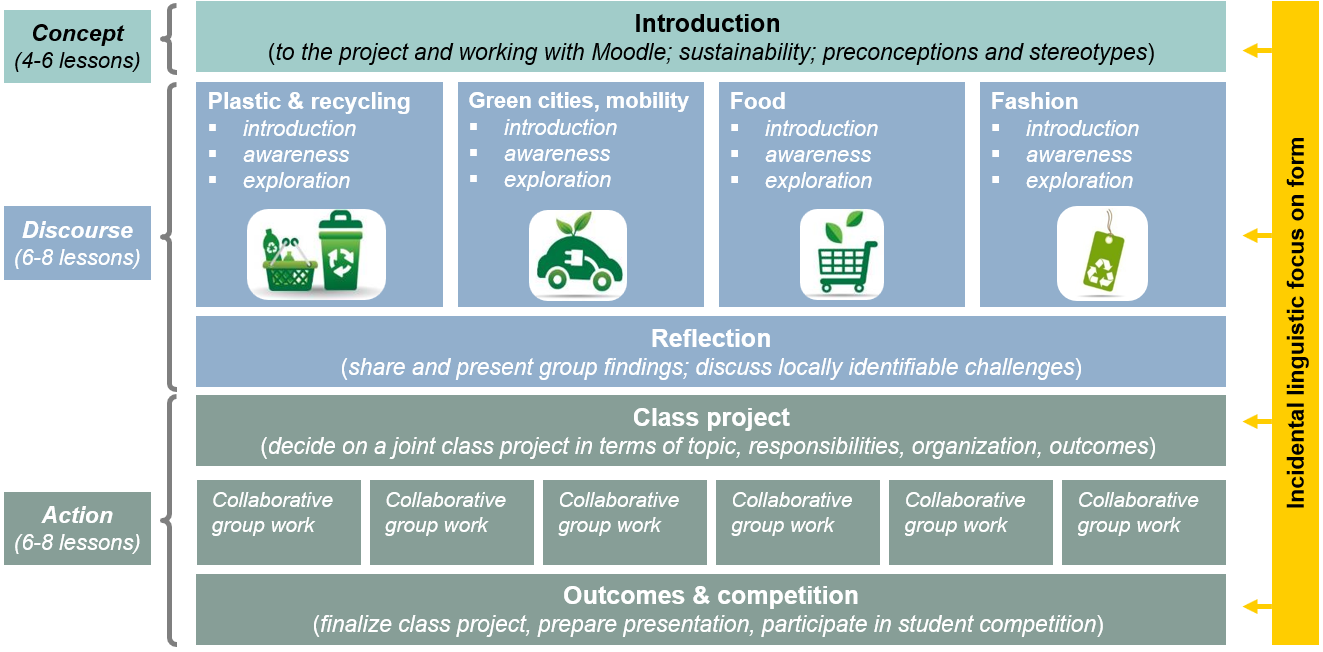
Determining What Students Bring to the Project: Stereotypes and Preconceptions
24In order to assess our learners’ pre-existing views about sustainable development on both sides of the Atlantic, we conducted a questionnaire survey investigating these research questions:- How do German learners in the Going Green project perceive and evaluate environmental sustainability in the US and Germany?
- What attitudes towards the environment and environmentalism do they think prevail in both national contexts?
- Which stereotypes do they express regarding their own cultural context?
- How do they frame their views argumentatively?
To this end, we analyzed learner responses to a reflective questionnaire task. The data were documented on the LMS as part of a classroom task and not for the primary purpose of scientific inquiry, which has direct implications for the evaluation of the data elicitation procedures and the participant sampling. Questionnaires have been employed in applied linguistic and pedagogic research as viable instruments to elicit attitudinal data about what learners think, their opinions, beliefs, values, and interests (Dörnyei and Taguchi). Open items can be especially insightful as they may provide unexpected and highly individual answers and, by allowing for self-expression, generate motivation among respondents (Mackey and Gass).
25At the project’s onset, the students completed the questionnaire task entitled “What are your attitudes towards sustainability?”, which includes, for instance, closed and open-ended items on learner attitudes towards sustainability, cognitive associations regarding sustainable development in both countries, and evaluations of hypothetical decisions (e.g., “Would you agree that it is ok to break the law in the name of the environment?”). They were informed that, upon submission, their answers would be published to all course participants to allow for a critical reflection on the outcomes either orally or in an online forum. For our analysis, we selected the first two open-ended items, which read: “Think of the US [item 1] / Germany [item 2] and its population’s attitudes toward the environment. Do you think there is a typical attitude? What words, ideas, or images come to your mind? Give some examples (at least three).” 26The sampled dataset consists of all questionnaire responses by the 2016/17 and 2017/18 project cohorts in Germany; that is 22 courses overall, or eleven from each cohort (see table 1). While more participants engaged in this activity offline using the PDF-based version of the project curriculum, e.g. by filling out handouts and collecting and discussing results in their classroom. These responses are unavailable to the analysis. Class grades ranged from eight through 13 (2016/17 cohort) and ten through 13 (2017/18 cohort), respectively. 16 courses were taught at various German state-based school levels: the Gymnasium, five at vocational schools, and one at a comprehensive school (Kultusministerkonferenz).
Two starkly different images of sustainability in Germany and the US
27We performed qualitative content analysis (Mayring) using the MAXQDA12 software and categorized the responses as either positive, negative, or non-judgmental. These categories were further differentiated until a complex category system emerged and categorical saturation was reached. The result was a document portrait for each of the two questionnaire items, in which every code in the data was assigned a colored dot. Taken together, they create a map of the distribution of categories across the dataset (see figures 2a and b). 28This quantitative analysis of learner responses reveals largely divergent perceptions of sustainable development in Germany and the US by the surveyed students. Regarding their views on the US (see figure 2a), the negative characterizations far outweigh the positive, with the majority of responses addressing unsustainable everyday practices, disregard for the overall problem of climate change, the negative impact of the economy, lack of political initiative, and the reliance on carbon-based energy sources. A starkly different image emerged in relation to the students’ own cultural context, Germany (see figure 2b). Here, positive characterizations of government effort and regulations for environmental sustainability as well as references to the renewable energy sector shape the learners’ responses although, as we analyze below, more differentiated responses were not infrequent in the data.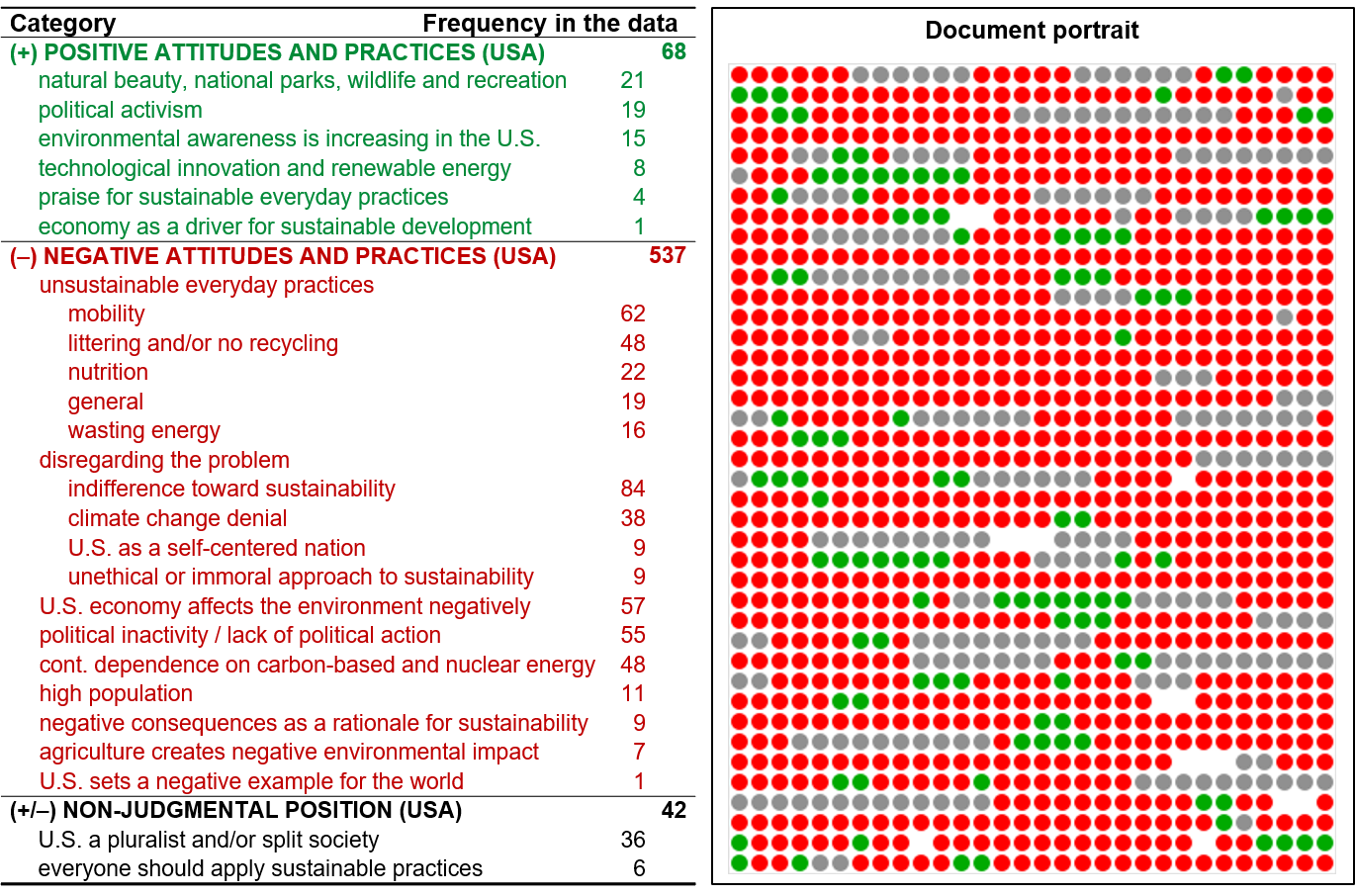
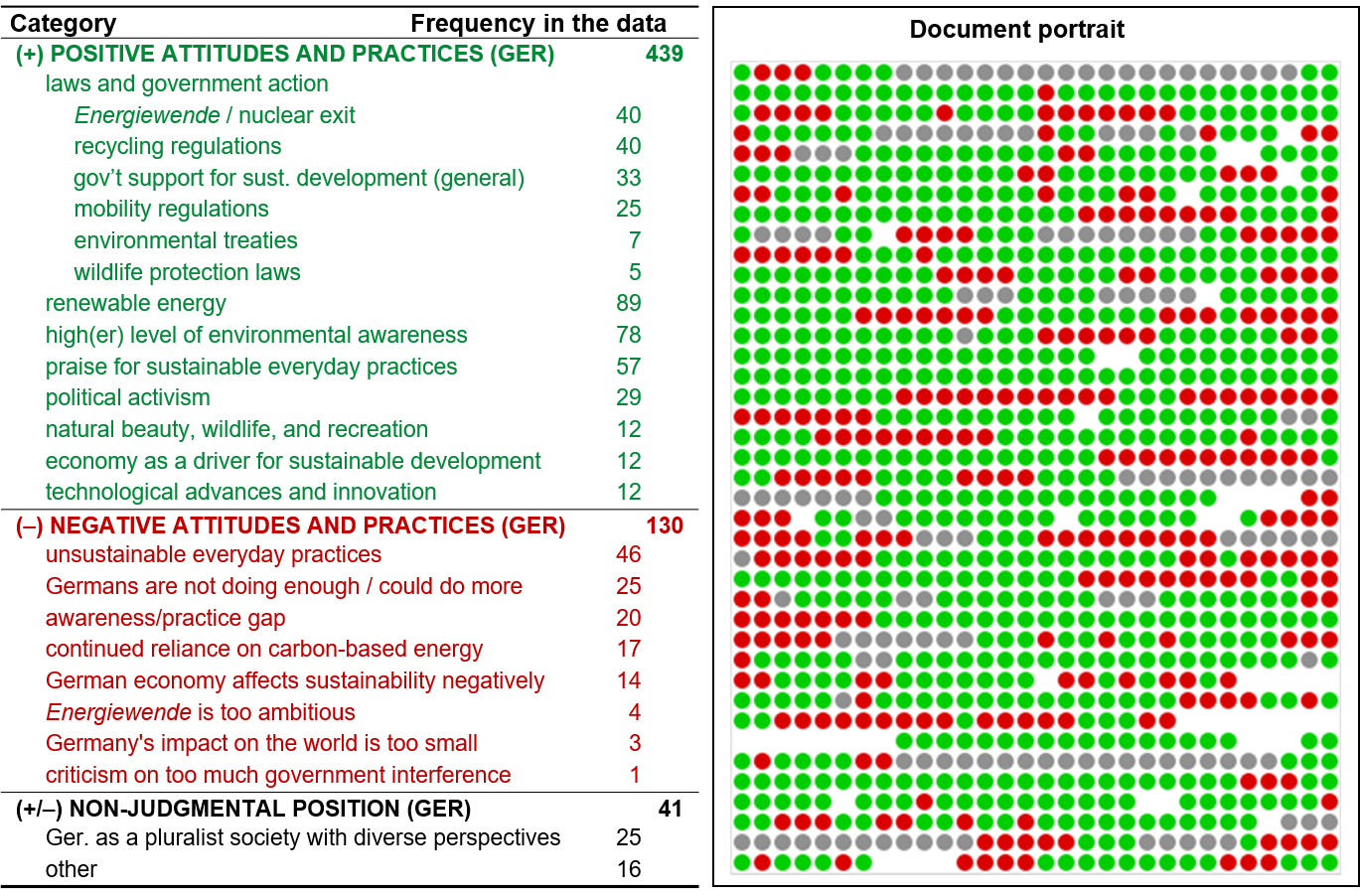
Figure 2a and b: German students’ perceptions of sustainable development in (a) the U.S. and (b) Germany. Left are the categories and subcategories with their absolute frequency in the data. In the document portraits (right), created using MAXQDA12, the colored dots proportionally represent the number and sequence of codes in the two data corpora (green = positive, red = negative, grey = non-judgmental).
Looking Under the Surface: Complex Structures of Cultural Stereotypes
29A qualitative analysis of these overall results demonstrated that our participants’s views were more complex and nuanced than both document portraits initially suggested. Corresponding with the four research questions stated above, we thus analyzed (a) how participants further qualify their answers generally, (b) what role they ascribe to the federal government in promoting or hampering sustainable development, (c) how they perceive extreme and fringe positions on sustainability, and (d) whether and to what extent learners express value judgments in their responses.(a) Germany, the model student, and the US an underachiever? True on the surface, but students’s views are more nuanced.
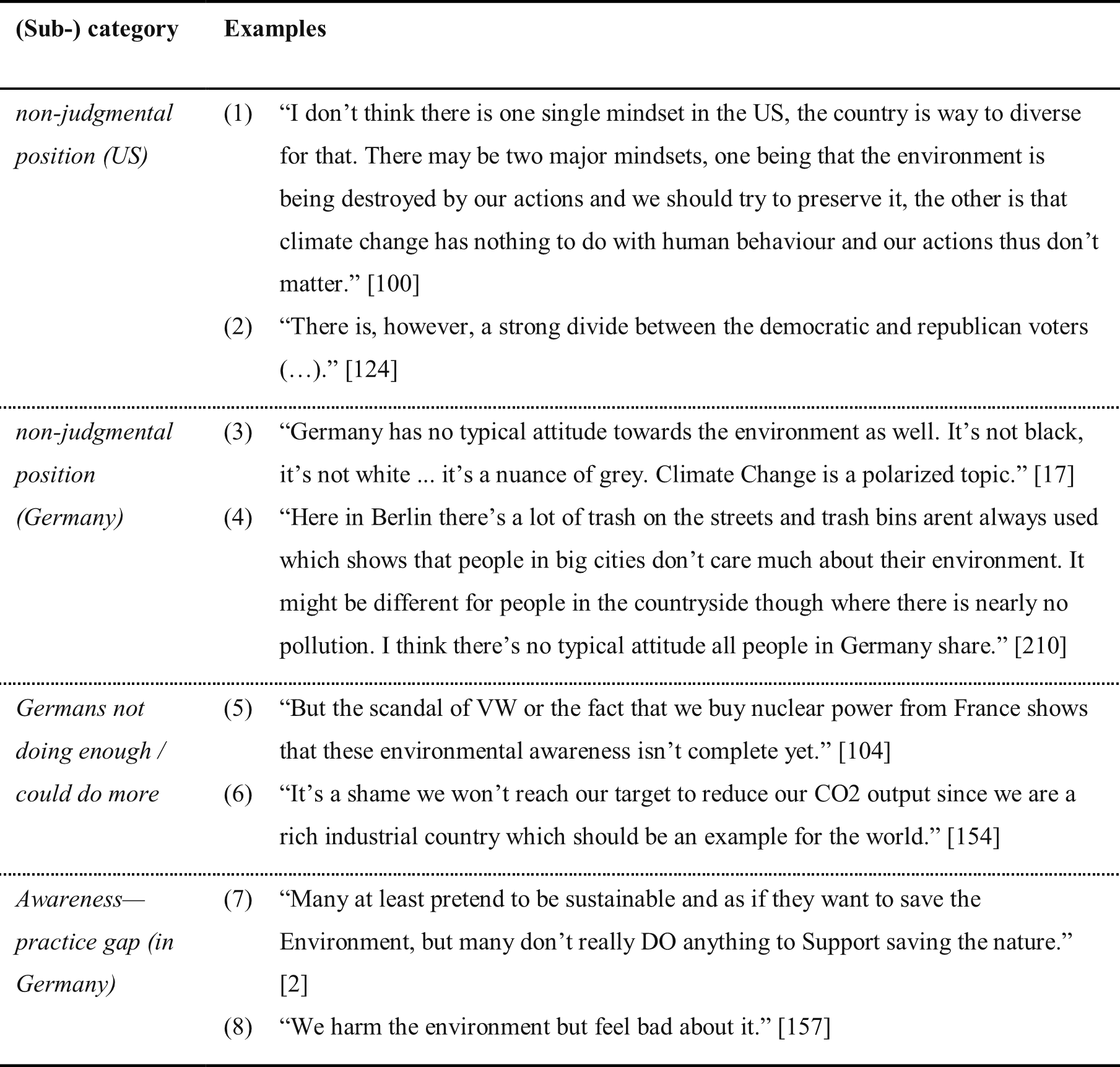
The surveyed learners differentiated their views on sustainability in both countries in various ways (see table 2). Some students made non-judgmental or rather balanced remarks about sustainability in the US, by stressing the plurality of views within the US society (1) or by casting sustainability as a partisan issue (2). Likewise, learners made similar non-judgmental remarks about their own cultural context (3, 4) and that a distinction may rather be drawn between urban contexts and the countryside (4), thereby expressing an auto-stereotype (i.e., stereotypes about one’s own cultural context). They also criticized that Germans, despite the country’s ambitious sustainability policies, are not pursuing climate action more aggressively (5, 6). In the same vein, some answers criticized a perceived awareness-practice gap among Germans, one between political rhetoric and everyday citizens’ actual behavior (7, 8).
(b) Extreme and fringe positions are mentioned disproportionally often.
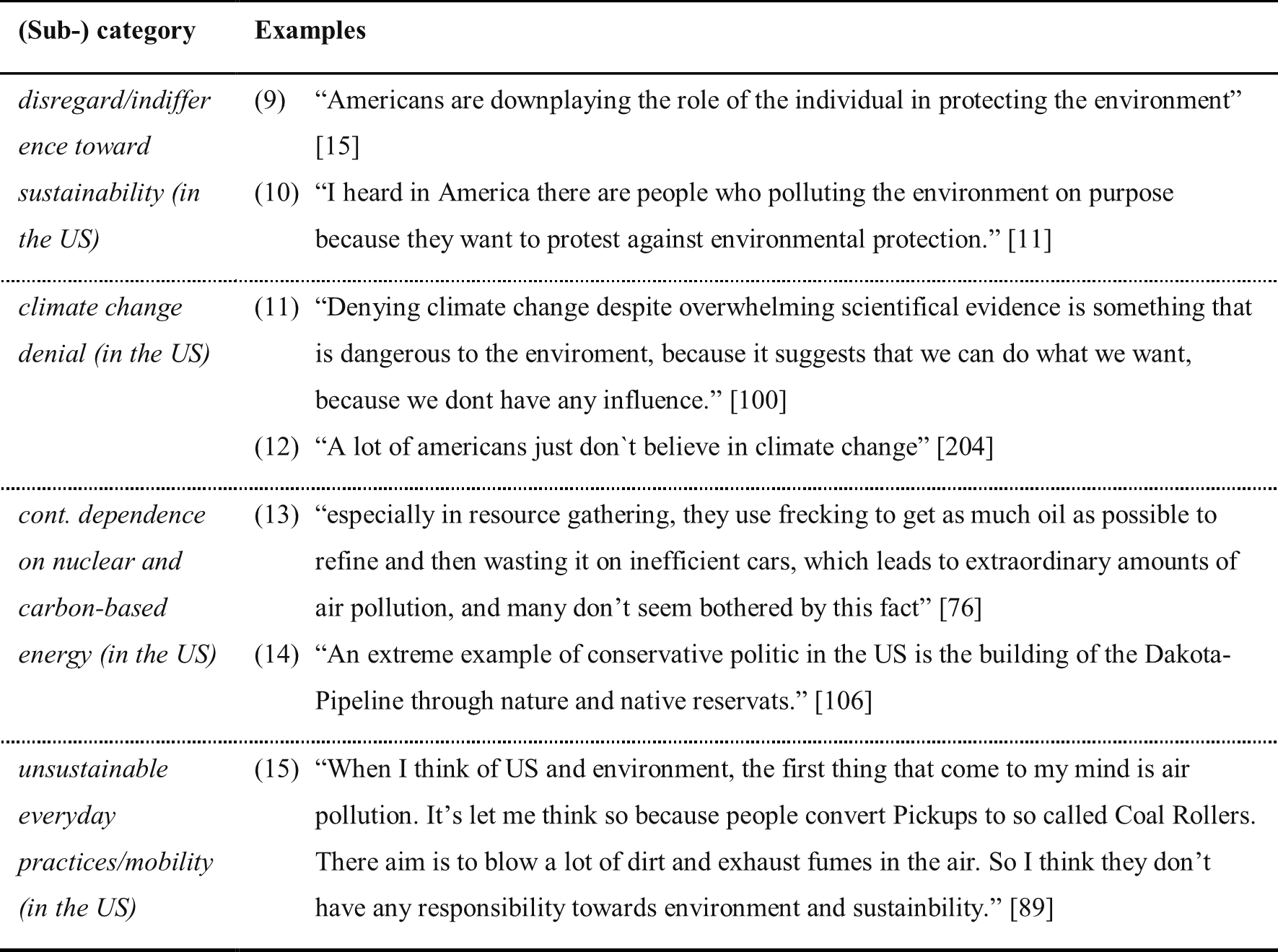
(c) Students overemphasize the role of the federal government in the US
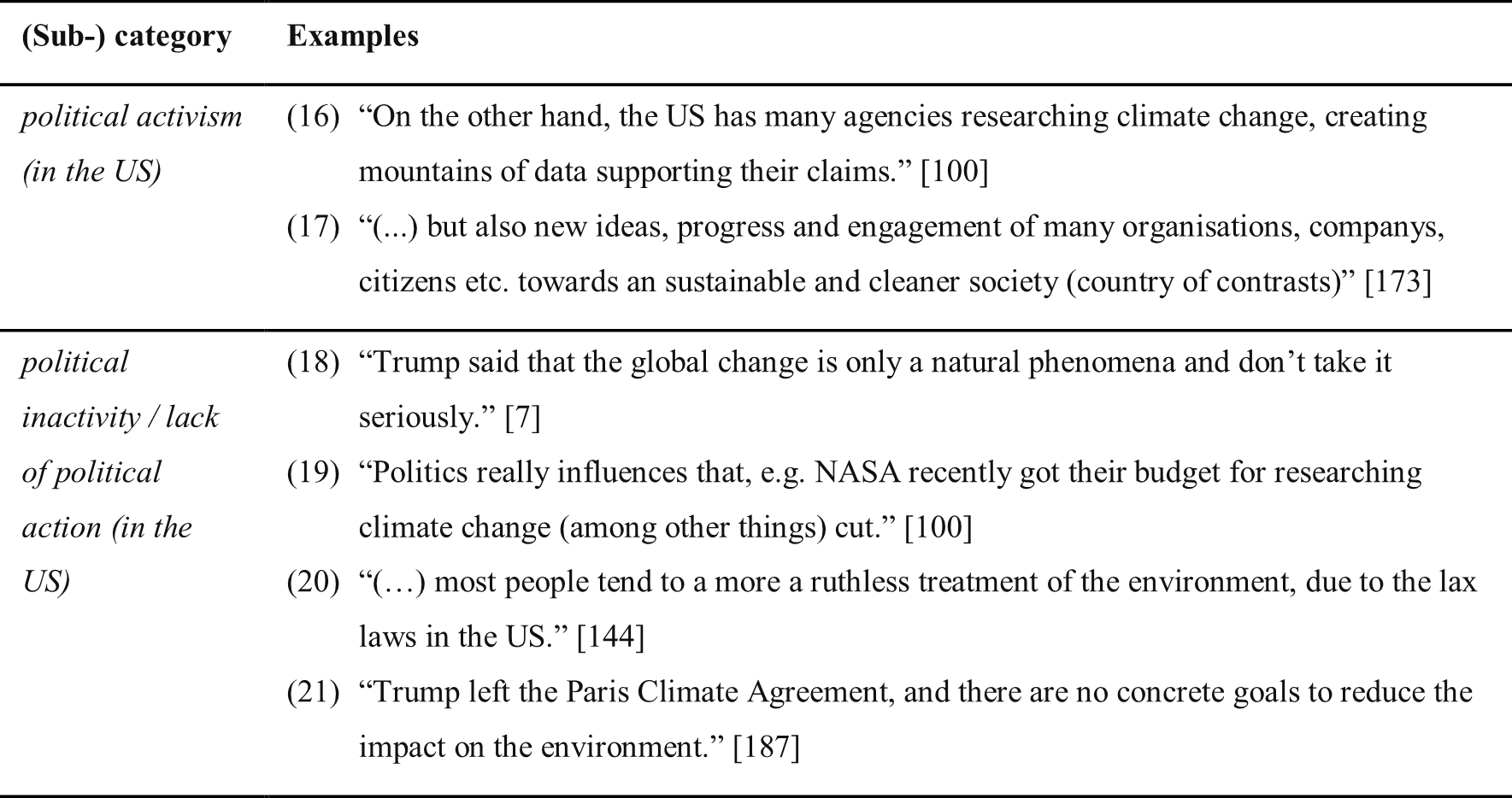
(d) Some learners adopt a moralizing perspective on sustainability
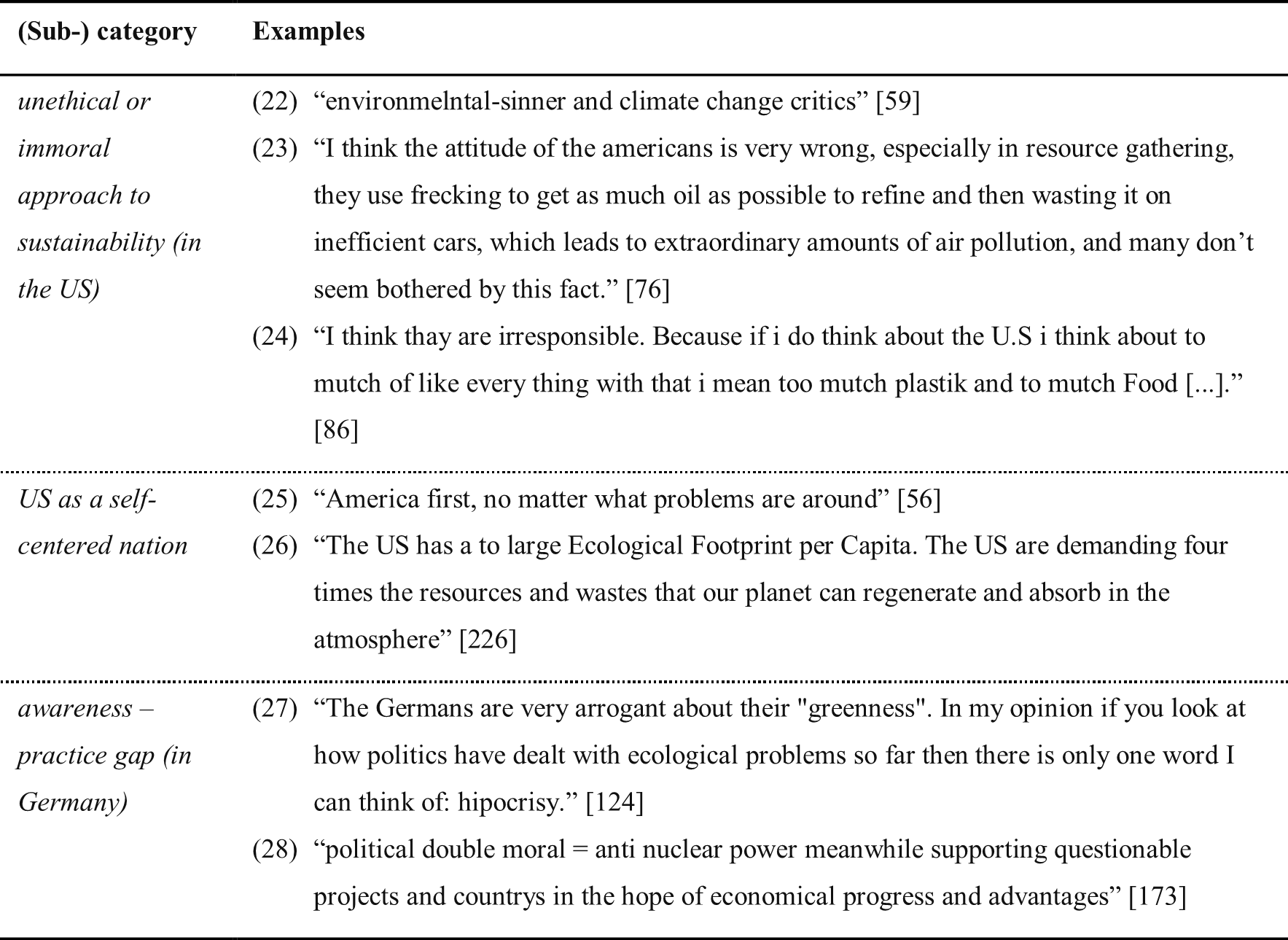
Turning Irritation into Learning through Counter-Narratives
36These insightful, yet somewhat sobering findings beg the question how to respond pedagogically—and here we return to the discussion of cultural learning in the EFL classroom.The classroom as a space for cultural negotiations of otherness
37First, the approaches of inter- and transcultural language learning, as well as global education, make a compelling argument for the language classroom as an ideal location to address the surveyed students’ cultural views. Michael Byram (65) argued early that the role of the classroom is not simply to prepare learners for potential experiences in the real world. Engagement in intercultural exchanges with otherness is a simultaneous process both inside and outside the classroom. Similarly, and extending this idea further to emphasize students’ agency, Hallet (39) conceptualizes the classroom as a discursive space of cultural encounters where learners, understood as cultural agents in their own right, engage in the discursive reception, production, and negotiation of cultural meaning in response to cultural texts and stimuli. 38Within this space, foreign language learners in general, and participants in the Going Green project in particular, routinely encounter three dimensions of otherness (Bracker 107–11). At the level of topics and contents, they are confronted with mainstream and counter-narratives of sustainable development in a foreign cultural and national context, the US, specifically in the civic and political sectors. At the discursive-linguistic level, these narratives are coded twice—in the target language and in the technical language of politics and science, which both can be markedly different from the learners’s everyday language. At the level of classroom interaction, learners exchange and negotiate meanings, divergent understandings, attitudes, opinions, experiences, and knowledge with their peers, as the survey results demonstrate. As we mentioned above, intercultural approaches to language education seek to transcend this dualism of other and self by engaging learners in processes of coordinating and traversing insider and outsider perspectives. 39Regarding the first level, topic and contents, the focus on sustainable development in the US opens a complex interplay of more or less dominant narratives that can result in different images of US culture in the classroom. We can imagine these narratives as different “publics” (Warner), which are open and constituted by virtue of people being addressed and participating in a (public) discourse, however loosely framed this may be. Our learners are only part of a limited number of publics, namely those that they are aware of and that they deliberately pay attention to. Pedagogy must extend this perception by pointing towards less salient, non-mainstream discourses—marginalized publics or those that learners find difficult to access because they are not attuned to them. Publics can be intersectional and permeate local or national boundaries, a key feature of transculturality. Discourses like those on citizen climate action, leading a zero-waste lifestyle, home gardening, or critical mass cycling activism, among others, all transcend national borders.Local Case Studies as Intercultural Rich Points
40And yet, the transgression of cultural boundaries seldom happens without friction and irritation. Cultural anthropologist Michael Agar spoke of “intercultural rich points” to frame moments of incomprehension between different cultural agents, “those surprises, those departures from an outsider’s expectations that signal a difference between [cultures] and give direction to subsequent learning” (2). Rich points represent boundaries between cultures where an idea or behavior tacitly taps into opaque cultural meanings in such a way that representatives of another culture are unable to fully understand them. We can exploit this concept in the classroom by countering common learner expectations with narratives that disrupt their cultural expectations by, for example, introducing them to non-mainstream publics and their concomitant discourses. 41Described as “seismograph of comprehension” (Combe and Gebhard 10), irritation can become a springboard for learning by initiating reflective processes and prompting critical comprehension questions of construction and reconstruction, and thus prove learners’ existing vocabulary and explanatory frameworks as insufficient to make sense of new phenomena. Such irritation in EFL directs attention to the process of comprehension rather than its outcomes and has the power to focus intercultural discourse on learners’ own identities and perceptions of what is, and what is not, considered ‘normal’ (Tödter 140). We can deduce from the above learner survey that case studies foregrounding the local government level as well as non-mainstream and marginalized discourses on sustainability offer a promising potential to serve as counter-narratives and engage learners in cross-cultural shifts of perspective, a hallmark of intercultural learning. Going Green addresses these counter-narratives directly in the self-study modules on plastic recycling, green cities, fashion, and food (i.e., the “discourse” phase of the project). 42The study module on plastics, for instance, introduces marine plastic pollution and the Great Pacific Garbage Patch and connects this issue to an exploration of the initiative by communities like Los Angeles, along with NGOs like Heal the Bay and the Surfrider Foundation, in promoting a statewide ban on single-use plastic bags. In the module on food, the issue of factory farming and genetically modified foods (GMOs) provides the backdrop to the case of Chipotle Mexican Grill, whose online marketing campaign supposedly marries the business model of a fast food chain with the ambition to offer locally grown, fresh, and non-GMO meals for competitive prices. Likewise, the module on fashion problematizes the trends of ‘fast’ and ‘toxic’ fashion as one factor causing desperate working conditions for garment workers in developing countries, which became tragically evident in the incident of the 2013 Rana Plaza factory collapse in Dhaka, Bangladesh, where over 1,000 people, mostly women workers and children, lost their lives. Learners are prompted to analyze varying reactions to the incident in the US, including decisions by some of the largest fashion producers to relocate their production from Bangladesh. Adopting a historic perspective, the module further parallels the current situation of these garment workers to the 1911 Triangle Shirtwaist Factory Fire in Manhattan, an incident that lead to positive developments in terms of workers’ rights, workplace safety, fire codes, and immigrant issues in the US. It thus models potentially productive reactions to such disasters going forward. Finally, in the context of “green cities,” learners explore two very different but insightful cases: Portland, Oregon, and the German city of Essen—two cities lauded as positive models of sustainable urban development—and their approaches to achieve a more livable and sustainable future for their citizens through policies and incentives addressing mobility, energy, and housing. Adhering to the notion of the classroom as a site of cultural negotiation and the need to scaffold learners in developing and practicing agency (Mercer) by participating in real-life discourses on sustainable development, these case studies become springboards for exploratory and research-based action in the learners’ own communities in the subsequent “eco-challenges.” 43Lastly, these examples demonstrate that the discussed counter-narratives, more often than not, unfold in digitally mediated discourses, precisely because they are not always covered in traditional mass media but instead emerge from the bottom up. Accordingly, participation in these discourses is most effectively achieved digitally, though this requires learners to develop an awareness of online genre conventions and agency to engage in these, often informal, discourse arenas (Reinhardt; Vandergriff). Social media and Web 2.0 platforms capture the topicality and immediacy of these narratives unlike most traditional pedagogic media, including the student textbook. Since new textbook editions are produced every five to seven years, they do not capture current events and transcultural developments the same way that web-based media can. Likewise, Chapelle warns that, “[m]aterials developers should investigate the cultural narratives that are relevant to the people whose language they are teaching” (225). This is a crucial goal when teaching cultural issues, and one that is increasingly difficult to achieve without a versatile integration of web-based resources and modes of communication and collaboration. 44In sum, Going Green attempts to narrow this gap through both its integration of global citizenship education and cultural learning and the use of digital technologies and online discourses. Our questionnaire study of the learners’ preconceptions regarding sustainable development in the US has shown that, although their views are not undifferentiated, many participants appear to overemphasize the role of extreme and fringe positions in the US sustainability discourse, overstate the role of the US federal government in setting the environmental agenda, and apply moralizing frameworks in cross-cultural comparisons. These findings, together with scholarship in the social sciences and foreign language pedagogy, highlight the importance of non-mainstream and counter-narratives for tackling cultural stereotypes. Likewise, they emphasize the pivotal role of teachers as well as teacher education and in-service teacher training in supporting and guiding the classroom implementation of appropriate teaching and learning practices. This affirms the findings of Burmester’s analysis of the development of cultural, social, and political stereotypes in two Going Green courses, which concluded that,45The effectiveness of such an approach can be inferred from the learners’ discourses and texts documented in Going Green and the various realizations of learner agency and community-based action in the project participants’ action plans. A discussion of these results, however, lies beyond the scope of this article. An analysis of such learner texts with a particular focus on the modification of intercultural perceptions and the development of intercultural attitudes and skills, complemented with introspective participant interviews and reflective writing would further illuminate these aspects. Finally, an investigation of the modes of sociocultural participation in the context of the learners’ action plans with the aim of developing a conceptual and pedagogic model of foreign language learner agency represents a necessary and promising continuation of this research.Going Green has begun to correct some misperceptions about American environmentalism and has also fostered the students’ consciousness for this issue and their own responsibility, in doing so addressing a common good and thereby possibly even shaping a ‘new’ narrative of transatlantic meaning. (Burmester 205–06, emphasis in the original)
Notes
[1] Going Green—Education for Sustainability is part of the educational outreach initiative “Teach About US,” funded by the US Embassy Berlin (Federal Assistance Grant ID S-GE210-18-CA-0002) and developed and implemented by Leuphana University Lüneburg and LIFE e.V. Berlin.
Works Cited
Adloff, Frank, Katharina Gerund, and David Kaldewey. “Locations, Translations, and Presentifications of Tacit Knowledge: An Introduction.” Revealing Tacit Knowledge: Embodiment and Explication. Ed. Adloff, Gerund, and Kaldewey. Bielefeld: Transcript, 2015. 7–17. Print.
Agar, Michael. “Culture: Can you Take it Anywhere?” International Journal of Qualitative Methods 5.2 (2006): 1–16. Print.
Anton, Daniela. Inter- und transkulturelles Lernen im Englischunterricht. Ed. Rüdiger Ahrens, Heinz Antor und Klaus Stierstorfer. Anglistische Forschungen 456. Heidelberg: Winter, 2016. Print.
Bartosch, Roman, and Andreas Köpfer. “Stadtnatur als Gemeinsamer Gegenstand im inklusiven Englischunterricht: Spannungsfelder und Möglichkeiten in der didaktischen Fachdiskussion.” Inklusion im Englischunterricht. Ed. Christiane M. Bongartz and Andreas Rohde. Inquiries in Language Learning 17. Frankfurt: Lang, 2015. 195–208. Print.
Bierhoff, Hans-Werner, and Elke Rohmann. “Sozialisation.” Stereotype, Vorurteile und soziale Diskriminierung: Theorien, Befunde und Interventionen. Ed. Lars-Eric Petersen and Bernd Six. Weinheim, Basel: Beltz, 2008. 301–10. Print.
Bogaert, Nora et al. “Task-Based Language Teaching in Science Education and Vocational Training.” Task-Based Language Education: From Theory to Practice. Ed. Kris van den Branden. Cambridge: Cambridge UP, 2006. 106–28. Print.
Bonnet, Andreas. “Sachfachlicher Kompetenzerwerb in naturwissenschaftlichen CLIL-Kontexten.” CLIL Revisited: Eine kritische Analyse zum gegenwärtigen Stand des bilingualen Sachfachunterrichts. Ed. Bernd Rüschoff, Julian Sudhoff, and Dieter Wolff. Forum Angewandte Linguistik 54. Frankfurt a.M.: Lang, 2015. 165–82. Print.
Bracker, Elisabeth. Fremdsprachliche Literaturdidaktik: Plädoyer für die Realisierung bildender Erfahrungsräume im Unterricht. Wiesbaden: Springer, 2015. Print.
Bredella, Lothar. “Fremdverstehen und interkulturelles Verstehen.” Handbuch Fremdsprachendidaktik. Ed. Wolfgang Hallet and Frank G. Königs. Seelze-Velber: Klett, Kallmeyer, 2010. 120–25. Print.
Brooks, Stephen. As Others See Us: The Causes and Consequences of Foreign Perceptions of America. Toronto: U of Toronto P, 2006. Print.
Burmester, Svea. Deliberative Diplomacy: Performing Democracy Beyond Borders: An Analysis of the American Embassy’s Going Green Project. Berlin: Duncker & Humblot, 2019. Print.
Byram, Michael. Teaching and Assessing Intercultural Communicative Competence. Clevedon: Multilingual Matters, 1997. Print.
Cates, Kip A. “Teaching for A Better World: Global Issues in Language Education.” Language Teacher 14.5 (1990): 3–5. Print.
Chapelle, Carol A. Teaching Culture in Introductory Foreign Language Textbooks. London: Palgrave, 2016. Print.
Chun, Dorothy M. “Contributions of Tracking User Behavior to SLA Research.” Learner-Computer Interaction in Language Education: A Festschrift in Honor of Robert Fischer. Ed. Philip Hubbard, et al. San Marcos, TX: CALICO, 2013. 256–62. Print.
Combe, Arno, and Ulrich Gebhard. Verstehen im Unterricht: Die Rolle von Phantasie und Erfahrung. Wiesbaden: Springer, 2012. Print.
Crabbe, Anne B. The Coach’s Guide to the Future Problem Solving Program. Laurinburg: Future Problem Solving Program, 1985. Print.
Dörnyei, Zoltán, and Tatsuya Taguchi. Questionnaires in Second Language Research: Construction, Administration, and Processing. 2nd ed. New York: Routledge, 2009. Print.
Fischer, Robert. “How do we Know what Students are Actually Doing? Monitoring Students’ Behavior in CALL.” Computer Assisted Language Learning 20.5 (2007): 409–42. Print.
Freitag-Hild, Britta. “Teaching Culture: Intercultural Competence, Transcultural Learning, Global Education.” Teaching English as a Foreign Language: An Introduction. Ed. Carola Surkamp and Britta Viebrock. Stuttgart: Metzler, 2018. 159–75. Print.
Garrett, Crister S. “Going Green: Federal and Local Initiatives in the U.S. and How to Teach Them.” U.S. Embassy Teacher Academy, ‘Global Challenges, Local Approaches: Teaching American Studies in the 21st Century.’ Lüneburg, Germany. September 2013. Keynote Address.
Gillis, Justin, and Nadja Popovich. “In Trump Country, Renewable Energy Is Thriving.” New York Times 6 June 2017. Web. 28 Oct. 2020.
Hallet, Wolfgang. Fremdsprachenunterricht als Spiel der Texte und Kulturen: Intertextualität als Paradigma einer kulturwissenschaftlichen Didaktik. Trier: WVT, 2002. Print.
Hauschild, Staci, Elena Poltavtchenko, and Fredricka L. Stoller. “Going Green: Merging Environmental Education and Language Instruction.” English Teaching Forum 50.2 (2012): 2–13. Print.
Heise, Ursula K. “The Hitchhiker’s Guide to Ecocriticism.” PMLA 121.2 (2006): 503–16. Print.
Hubbard, Philip. “Making a Case for Learner Training in Technology Enhanced Language Learning Environments.” CALICO Journal 30.2 (2013): 163–78. Print.
Kaliampos, Joannis. “Green Your Community Click by Click: Lokale Nachhaltigkeitsprojekte auf einer blended-learning-Plattform präsentieren.” Der Fremdsprachliche Unterricht Englisch 144 (2016): 32–39. Print.
Kultusministerkonferenz. Basic Structure of the Education System in the Federal Republic of Germany. Kmk.org. 2017. PDF. 28 Oct. 2020.
Lippmann, Walter. Public Opinion. New Brunswick: Transaction, 1992. Print.
Mackey, Alison, and Susan M. Gass. Second Language Research: Methodology and Design. Mahwah, NJ: Erlbaum, 2005. Print.
Mayring, Philipp. Qualitative Inhaltsanalyse: Grundlagen und Techniken. 12th, updated ed. Weinheim, Basel: Beltz, 2015. Print.
Mercer, Sarah. “Understanding Learner Agency as a Complex Dynamic System.” System 39.4 (2011): 427–36. Print.
Nunan, David. Task-Based Language Teaching. Cambridge: Cambridge UP, 2004. Print.
Oblinger, Diana G., and James L. Oblinger, eds. Educating the Net Generation. Boulder, CO: Educause, 2005. Print.
O’Sullivan, Emer. “Discourses of Internationalism in Children’s Literature.” Child Autonomy and Governance in Children’s Literature: Where Children Rule. Ed. Christopher Kelen and Björn Sundmark. New York: Routledge, 2017. 30–42. Print.
O’Sullivan, Emer, and Dietmar Rösler. “Stereotype.” Metzler Lexikon Fremdsprachendidaktik: Ansätze – Methoden – Grundbegriffe. Ed. Carola Surkamp. 2nd, updated and extended ed. Stuttgart: Metzler, 2017. 339–40. Print.
Prensky, Marc. “Digital Natives, Digital Immigrants Part 1.” On the Horizon 9.5 (2001): 1–6. Print.
Reinhardt, Jonathon. “Social Media in Second and Foreign Language Teaching and Learning: Blogs, Wikis, and Social Networking.” Language Teaching 52.1 (2019): 1–39. Print.
Roberts, Timmons. “One Year Since Trump’s Withdrawal from the Paris Climate Agreement.” PlanetPolicy. The Intersection of Energy and Climate Policy, 2018. Web. 28 Oct. 2020.
Rosenthal, Caroline et al., eds.. Disrespected Neighbo(u)rs: Cultural Stereotypes in Literature and Film. Newcastle upon Tyne: Cambridge Scholars, 2018. Print.
Roser-Renouf, Connie, and Edward W. Maibach. “Strategic Communication Research to Illuminate and Promote Public Engagement with Climate Change.” Change and Maintaining Change. Ed. Debra A. Hope and Rick A. Bevins. Cham, Switzerland: Springer International, 2018. 167–218. Print.
Rost, Caterina. “The Divergent Trajectories of an Idea: Sustainable Development in Germany and the United States.” Diss. University of Washington, 2017. Print.
Schulze, Sylvia. Landesbilder deutscher Schüler von Großbritannien und den USA: Die Bilder deutscher Gymnasiasten verschiedener Jahrgangsstufen und Herkunft (2008). Frankfurt: Lang, 2011. Print.
Siepmann, Philipp. Inter- und transkulturelles Lernen im Englischunterricht der Sekundarstufe II: Das didaktische Modell der Transnational Cultural Studies in Theorie und Unterrichtspraxis. Frankfurt: Lang, 2016. Print.
Thiele, Martina. “Medien und Stereotype.” Aus Politik und Zeitgeschichte 9 (2016): 23–29. Print.
Tödter, Mareike. “Was ist das „Fremde“ im Fremdsprachenunterricht?” Die große Frage: Normen, Konzepte, empirische Befunde und Anwendungsbezüge in der aktuellen Fremdsprachendidaktik. Ed. Sabine Doff et al., 2019. Print.
Vandergriff, Ilona. Second-Language Discourse in the Digital World: Linguistic and Social Practices in and Beyond the Networked Classroom. Amsterdam: Benjamins, 2016. Print.
Volkmann, Laurenz. “Challenging the Paradigm of Cultural Difference and Diversity: Transcultural Learning and Global Education.” Global Education: Perspectives for English Language Teaching. Ed. Christiane Lütge. Vienna: Lit, 2015. 19–37. Print.
—. “On the Nature and Function of Stereotypes in Intercultural Learning.” Teaching Cultural Studies. Methods—Matters—Models. Heidelberg: Winter, 2011. 15–38. Print.
Warner, Michael. “Publics and Counterpublics.” Public Culture 14.1 (2002): 49–90. Print.
Suggested Citation

This work is licensed under a Creative Commons Attribution-ShareAlike 3.0 Unported License.


